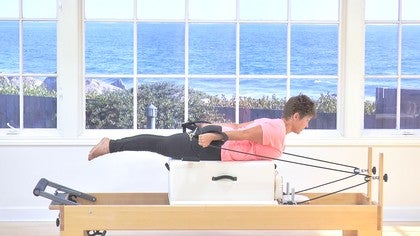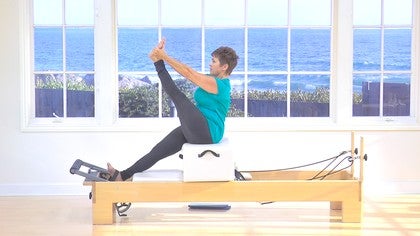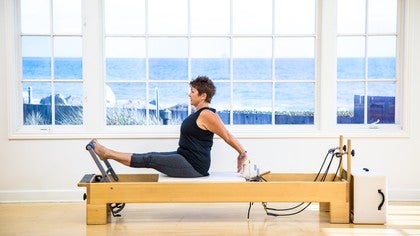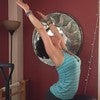Description
About This Video
Transcript
Read Full Transcript
This is the third in a series, this reformer workout. We'll be a little more connected. There'll be some other exercises that have advanced from previous exercises. And you'll notice now that the jump board is on, we're going to do our footwork on the junk board. And then I'm going to talk you through and engage you in a little jumping series, paying attention to the trunk and the neck and things that can change while we jump in the footwork. To start in this workout, there are only two red springs because what I want you to be aware of is that even though there are only two springs on this footwork, the exercise is hard in a different way.
So this foot board now is giving me some added proprioception. If you will. Feet press down as I go out, feet press up as I go in. Now let's change it. Feet press up. As I go out, feet press down as I go. I'm in. Changing the pressure of my feet in each direction. ADDS a little challenge to my spine to not move well actually it adds a challenge to the spine to want to move.
So my spine muscles have to work harder to maintain the integrity of the neutrality and the softness in the neck, softness in the face if you will, and then bring it all the way back in. Switch to bird feed. So I'm going to put my feet on the top now and I'm going to curl my toes over the top, pressing through my yields, making this connection here eight times kind of quickly. It's a light spring. It almost is going to feel like jumping, but I'm going to work the control here. So push switch to pull. Inhale straight legs, exhale, bend, knees, press and pull three more times relaxing, neck, scooping and belly, soft shoulders. And then come in. Switching now to PyLadies v squeezing my heels together. Neutral pelvis.
There's a tendency here. As soon as you lift the heels, there's a tendency to curl up, but you're going to lengthen yourself all the way out. Press and then pull and pull eight times. Here's three. Try to touch those thighs together. Squeezing way at the top of your groin area. Press and Paul. Four more and three more and soft. Neck and throat. Two more. And last one and bring yourself all the way in. Close the legs.
One leg, bring one leg in a table. Top. Press with the left leg by itself. Lengthening this thigh all the way out. Neutral pelvis comes in only five, two and three. Press the leg away, four and five, right leg down. Press and bench press. So again, that heel is pressing away. I'm just demonstrating with my hand and then for us and come in.
Bring the leg down. Bird feet, one leg go. Now I'm going to add a leg variation on the right leg. So press and bend. Two stable trunk. Check in with your neck. Last two and last one.
Other leg goes one and down two. Don't curl your tailbone. Stay neutral. Three engaging the back of the right leg for the last time. Five hold one hold two belly pulls in three and soft. Neck four and five. Lower the leg down.
Baladez is v now with left leg starting the right leg is coming up. It's gonna stay in this v position, stretch and bend, but only one leg is doing the work. Stable trunk soften, neck relaxed my eyes to more. And then last one, right leg down, then press. So the one legged work is actually putting a little rotation force on the spine. If this is too challenging for you, you of course go back to the two legs, the last one and bring the leg in and lower yourself down.
Heels apart on the top part of the jump board. Now the legs are a little bit wider apart than they were on the Footboard d the pelvis has long stomach pulled in press and bend press. Keeping your pelvis in a neutral position here really allows the balls of the hip socket to kind of roll in and roll out so we can really feel the work in the hips with a stable trunk. And here we go, three and four and last time five and then come in balls of the feet and here we go. Press eight times here to soft face. Looking straight up at the ceiling and four more, three more. I'm, I'm just know showing you these positions that we have to keep neutral. And then rib tip to Hib, tip hip tip and then last one and bring yourself in and then close the legs are going to switch now to the arms in the straps here, belly in arms pull five times, arms alone, one to check in with your neck.
Notice the first place on you that tends to want to change might be your back, might be your neck, might be rounding your shoulders. You have to make that discovery circles down out, up five times two and three connecting for letting the balls of the socket rotate in the shoulder. Five triceps, go one and two. You can let the shins rest down. Three and four last time, five press hold and hold straight arms all the way up. Let the feet come to the bar and pause right there.
Adding the trunk flection challenge. Now getting ready for the a hundred beats, arms, press, knees, float, lift, head curl, trunk, all those things happening and then everything rolls down. Sometimes when you do that, you feel like your shoulders get jammed in here. So I'm just going to move myself away because I kind of felt that happening. So don't hesitate to move your torso so you don't have to fight with those shoulder rest arms, pole, Chin nods, forehead curls towards the thighs and then reach long hold and hold and hold and then slowly lower yourself down. One more time. Arms pull, trunk curls, a hundred beats go.
I'm going to grab my little pads here. I'm going to prepare for jumping. I'm going to take these and put them kind of behind my head just to raise my head and my chest up a little bit more. There's a tendency when you jump for the shoulders in the chest to kind of lurch. I'll show you what that looks like. So your heels are on here. I'm going to press the carriage back to straight legs. Neutralness here.
I'm just going to raise my heels up and down and then bend the knees in and now I'm going to push off the board. There's two on there. It's gonna feel like I'm going to fly backwards.
It's almost like you want to focus on the legs versus the core, but you're understanding all that now. So ward join, join me here and we'll do 10 just two legs jumping. So press come in, press catch, check in with this trunk. Check in with the legs. Three more, two more, and then last one and then release. Check in with the head. For some people they actually have to be lifted a little bit higher and it helps their trunk stay a little bit stable. Let's jump with one leg now.
Turn to parallel. Right leg up, left leg jumps five times. Go One, two, three, four, five, switch legs, five, four, three, two and one. And then bring yourself all the way in. There's whole classes on jumping, but this gives you a good understanding of how you start with that series. Get your heart rate going. You can kind of hear it in my voice. I feel a little warm and my legs are connected as well.
Now move on to my legs in the strap. So I'm going to press still. Got Two springs on my legs. Come all the way in this drops, vertical position, press and Ben. Same fundamental connections that we've made. There's going at a little clipper, little faster clip if you will. Three more two, and then one leg circles parallel up, open down close. Nice, strong connection through the thighs, softness in the neck and the face. Two more times.
Last one in this direction. And now we're reverse. Press down, out and up. Down, out, and up. One more time. Down, out and up. Externally, rotate the legs. Inhale up. Open. Exhale down close. So don't shorten the distance here between the hip and the trunk. That will be the next exercise. One more time. And now we'll reverse it down and out. Up in it.
Squeeze the thighs up in, in school. Where's the thighs? Up and in. One more time. Take the legs out, bring them up. Then the knees in pause right here. Now. The next exercise we're going to do or that I'm going to do is a baby short spine. So I'm going to put my head rest down because whenever you bring your legs kind of over your head, the head rest always needs to be down.
And I'm going to take the little pads out so that I'm flat. Take the legs, let my legs float backwards, but I'm still pressing them away to keep the connection. I'm going to allow the weight of the spring to start to curl. My tailbone is making an invitation and bend my knees in. Pull my heels to my bum and roll myself down. So the weight of the springs on the straps pull my legs in this direction.
My buttock starts to lift just a little bit. I bend the knees, I roll myself down. I'm activating the muscles of my leg and not aggravating the muscles of my neck. So I use to you. I have to use the legs. I bend in and I start to lower myself down a couple more times. Inhaling, exhaling, open chest, legs, press Ben Knees. Exhale down.
Last one. Inhale, exhale. Inhale and then broad in the ribs as the legs come all the way down, making a connection. Now I'm going to take both my legs out at the same time. Let my hands stay in the straps and bring them down for our next connected exercise, which we call coordination. We're going to combine a couple things together. The arms press as the trunk curls.
We already know that from a hundred beats the leg stretch. We already know that from a hundred beats and then the knees come in and then the elbows bend and I lie myself down. I'm gonna put that together, holding the up shape. It looks like this. You can watch one time and then you can join me for the next set of three. So I try set my arms down as I kicked my legs out and curl my trunk.
Open. Close, knees fold, elbows fold. I'll lower myself down. Now you're ready to join me. If you don't have a reformer actually or you want to practice just on the mat, go ahead and mark the exercise without the reformer. Here we go. Inhale, exhale, pause. Inhale, fill your back, lungs
Check in with that head around and then stop. Reverse the direction around and stop. Bend the knees, bend the elbows and rest. We could stop right there. That'd be a great workout, but we've got some other things to accomplish. So we're going to roll off. I'm going to take my jump board off. If you put your jump board on, you can certainly take it off.
Now there's enough time to do it and we're going to prepare for a short box so you can have that in your brain as you take the junk board off. Okay. So with short box, now you're going to have all my springs on for support. I can use a pole in my hands. I can use some weights. I'm not gonna use anything in particular today, but understand that you certainly can as a different kind of challenge. And I put my foot bar down.
Take my strap out and have a seat without a lot of explanation here. We're going to go through this whole series here. Inhale, exhale, roll back. Inhale, exhale, curl up. Inhale, exhale, spine, stretch forward.
Inhale, exhale, curl.
The twist gives the oblique a challenge. The hinges back maintains the challenge. Oh, I was quivering on that one. Inhale, right. Exhale, hint. And then return arms come down. Climb the tree. Get it right under there to start with. Grab that wrist.
Here we go. Try Not to change this shape of your spine. If you need to cut yourself some slack, you can lean back a little bit. Last one, flex point. Flex 0.1 more time. Flex.
One more time. Point climbed the tree, right arm, left arm, right arm to the foot. Grow Up. Bend the elbows. Pull your leg to your face and your face to the leg. Hold five hold for hold three hold to hold one, bend the knee lower down. That exercise will also build to rolling backwards.
Other leg up in the torso. Belly is pulled in. Hold the wrist, straighten and then bend. Keeping that connection hold and then flex hen press flex and press. Last time. Flex hold. Climb left arm, right arm, left arm, right arm long chest without leaning that head back. Use your elbows and your shoulder blade to grow up tall so your leg is actually reaching up to the ceiling as everything pulls closer together like a Taco and then bring that knee in and then slowly lower yourself down.
We're now going to prepare for the side plank or situps, but we're actually not going to do them. It could be a dangerous exercise actually if you just kind of overhang your body, but we're going to start by creating a side plank connection. So I want to have enough tension in my strap that it can kind of support me. I'm going to have this leg bent. My belly is pulled in. There's a tendency in this exercise to just kind of hang and you'll notice there that this is all overstretched and this is short.
So I'm going to bring myself up to level. I'm going to take my hand to the headrest and barely hold down. I'm going to take my head in line with my spine and my right arm out to the side like a tee, and I'm going to soften my neck and I'm just going to breathe. I can let this hand go, I can put it here, but I'm not doing any movement. I'm getting really good stability. As I hold this side plank position, my arm comes down, I push myself back up in that side position over the box.
There's some stress that takes place between your joints and your discs and things like that. So we're just going to work first to create that holding pattern. Much like we did when we created legs out in, in, in single leg stretch much how we did when the trunk twisted in a hundred beats. I'm going to do it again. There's a tendency in this exercise to lurch yourself forward.
You can't really see that on the camera unless the camera was coming down from the top. So I'm going to pull my tummy back. That same soft neck that I need, same lengthening in the back of my neck. I'm going to recognize myself as a level plank here and then bring myself up, turn around face the other direction. Again, there's a tendency to hang. We're not going to hang. We're actually gonna lengthen. Put my arm down.
If I had a a moon box here or something that was stacked up, I may even put my arm out a little bit higher. So I just want to lengthen up my ribs, left arm, right arm down. I can actually push into this head rest it really interesting feeling. Helps me connect through my torso, holding and holding and I'm going to take that handout just for a second and just hold it there so I really feel the whole lateral line of my torso all the way up and then bring myself all the way up. Again, that side plank just helps prepare us for the advancement of the exercise.
Really good to keep those stabilizers in check as well. I'm going to turn the short box to the long box. Now we repeat some of our previous exercises because I really want you to get the feeling again of that thoracic extension because the new exercise we'll be adding is called down stretch where we wanted an extension in the chest. So I'm going to bring myself on my tummy here, lower my body down, engage the back of my thighs, hands on the bar out and in three times, no spinal extension. One inhale too. I'm moving from my arms and not by shrugging my shoulders. Three engaging through the legs last time. Inhale, prepare.
Exhale moves you back. Inhale slides the bones into the joint. Peel my chest up one and down. I'm doing three of these each time. I'm going to bring myself up higher from the action of my chest bone, reaching my heart shining forward and then come down. I cannot be in a hurry to lift my head, but I can be in a hurry to lengthen that chest. Lengthen, lengthen, lengthen, and then lie myself back down. Bring myself, yeah, in a lower this foot bar. Now turn it around to pulling straps, looking for that same thoracic extension, but now I'm adding the challenge of the straps.
This time I'm going to pull the straps and extend simultaneously. That's a very, a typical exercise here. My arms on the side of the reformer knuckles reaching law. Inhaling, exhaling three times. Inhaling, exhaling last time, shoulders, arms, chest lift, hold, hold. Tighten those triceps in those arms and then lower yourself all the way down. Take the arms out to the side like a t, and I'm actually going to lower my arms a little bit so they're not on that duct tape anymore. They're out to the side here. Parallel to the floor, lengthened out the straps, a bit like a t. Inhale, lengthen. Exhale, return the arms. Stay parallel. Inhale, don't be in a hurry to lift those legs. Lift the chest instead.
One more time. Chest lifting. Lengthen yourself all the way out. Now with that feeling of your chest nice and extended, I'm going to take you through the exercise that we call down stretch. I'm going to teach you the exercise down stretch and then we'll put it in the series where it belongs.
I'm actually going to raise this foot bar up so it gives me a little bit higher height to try to get the extension through my chest. Exercise starts here. I get the feeling. First I have to get into hip extension. This is hip flexing your agree. So I have to press my legs backwards to get the hip extension. And then I'm going to bring my chest forward, my thighs engage, my chest lifts, like mat arms, working, chest lengthening, buttocks working, and then that shape goes inhale, exhale.
So I don't have any more extension. I hold the shape and I work the outface and work the in phase one more. And then I bring myself all the way in and hopefully I had a complete extension from my lumbar curve up to my thoracic spine. That exercise is always a work in progress. It's just really important that we don't hang into the back.
So what I'd like to do now is put that exercise where it goes in the long stretch series. So you know that we worked on our elephant exercise in the previous workout and we also worked on our plank. So now in our long stretch series, the word series implies that lots of exercises go together and I'm going to create that. So the exercise we're going to put together today is long stretch, which is your plane. It's kind of a moving plank down stretch, which then takes you into extended position. That's the exercise we just did. And then elephant, which kind of like pikes your bottom up in the air and creates it that way. Okay, so the exercise, you can join me here. You Watch me get on first.
Actually, I'm going to bring myself out here. We call it a clean entry. So we're going to take ourself out here and take the second leg up and hold just like that. And then when I stepped down, I'll get off and bring myself back up. So we're going to try it together. Ready? Right hand, left foot. Right here. I'm already connected through my torso. I'm already connected through the back of this left leg that also have to do to get into the plank is just bring my other leg up. Long stretch
Try to imagine your chest coming through your arm, but don't bend your elbows. Like I just did. Straight arms. Pull that chest forward. Straight arms squeeze thighs. Lengthen the chest bone. One more time. Exhale, lift up, lift the chest, lengthen back and then bring yourself all the way back and around how convenient. We end up in knee stretches. Pull the belly in. So now we've taken our spine from that extended position.
We're now coming into that flex position, holding knee stretches and here we go.
Now our torso is working in a more lengthened position, so still we don't want to see saw the spine. Three more. Two more. Last one. Come in, curl the spine one more time. We're taking the left knee up. Look at, we're putting the foot right where the knee was about. I'm going to lift this heel up, curl my tailbone, pull my tummy and I'm going to hover my right knee off the mat. Here I go. Pull it up, hover it up, push pull, elbow straight, spine stays curled, Chin in, three more, two more. Last one, lower yourself down. Switch legs.
If this is too tough, you would just go back to the same regular knee stretches. If this is really too tough and you just want to practice the lifting, look it, just add another red spring knowing that you won't be able to move the carriage out and in, but maybe putting the heavy spring on will just allow you to get this feeling. It'll just allow you to get that hover because sometimes that hover is so important. Gets both the legs going. Let's try that again on this side. Inhale, big exhale. Just hover, just hover, just hover and then lower down. And then when you're ready, take that spring back off again. And here we go. Hover with the movement. Hover moves five times, one, two, three, four and five. And bring your leg all the way down.
Step off three springs. Lie yourself down.
Some people leave the head rest up for bottom lifts and you're not lifting it all the way up and do a bridge. I certainly understand that neutral lift, but to fis underneath your bottom, feel that distance. Open up the chest. Here we go. Eight times to three. Melt your face. I know that sounds like a weird cue, but I think you know what I mean that you don't want to tense up the neck for three,
Put your feet on the bar, inhaling and exhaling, and then bring yourself all the way off.
I'm going to make my arms as wide as I can. I'm going to press down to lift up and then I'm going to bend my elbows and use my legs and press myself back up. So as I bend my elbows behind me, I noticed that my hands are kind of slipping because they're sweaty a little bit. So I'm, I might could do better with some sticky pads, but for the sake of time here, I'm sure you understand that pressing up and down. Now hold this down phase. Even though my elbows are bent, I'm still pressing down. Chest lifted, right leg up, press right lift left, press left, lift right one more time and lift and then bring yourself up and turn yourself around. The last exercise that I want to do is going to prepare you for front split.
I'm not going to do the front splits on the reformer. It's kind of a tough exercise. So I just want to create it safely, make some connections. And when you practice with your teacher or practice in a class or you look at another course online here, you might be able to find it in a little more detail. On the moving part. I like to create safety first. It looks like this. I'm gonna take my right leg and press it down into the ground.
My left leg comes up on the bar, looks like this. So my torso, my hip socket is back, my Belize lifted and my trunk is long and strong. I just want you to notice this position and now I want you to notice this position because some people think that this is long, but you see how it's my, my front ribs are bigger and my back is shorter and I got this big bulge here in my thigh going forward. So I have to take this hip socket here and I have to bring it back so it actually is in line over my foot. So what happens is we get a little more wobbly but then we actually feel a little bit better right in the hip socket. So the arms going to raise all the way up in the air and then I'm going to hinge forward from the ankle of my standing leg and then come back.
The ankle joint of my standing leg is what takes the whole package of my body forward. That allows me to have a butt connection and a thigh connection and then I bring it back up and I lower down switching legs. You can repeat this on the ladder barrel. You can do this same exercise with your foot here. Let's do it here. So that might be a little bit high for some people. Again, the most important thing here on this left standing leg is that the hip socket is indeed back with your hip socket in the right position.
It allows for better kind of key connections all the way up through your torso. So arms up. This is not what it is. That's not it. Thigh socket, back trunk, long crown to the headlong. Hopefully you could see that difference hinge from the left ankle. Whole package forward. Push with your right leg, whole package back, whole package forward. Work the back of the left buttocks thigh, bearing yourself all the way back last time.
Bring it forward last time. Bring it back, arms down, growing tall. Take your right leg down. Very good. Thank you for joining me for these reformer series workouts. I hope you see that the fundamentals were created in such a way that made the exercises come alive.
Key Connections: Reformer Fundamentals
Comments
You need to be a subscriber to post a comment.
Please Log In or Create an Account to start your free trial.
















 fundamentals for the re-connection, I can get so far ahead of myself sometimes ..
fundamentals for the re-connection, I can get so far ahead of myself sometimes ..




